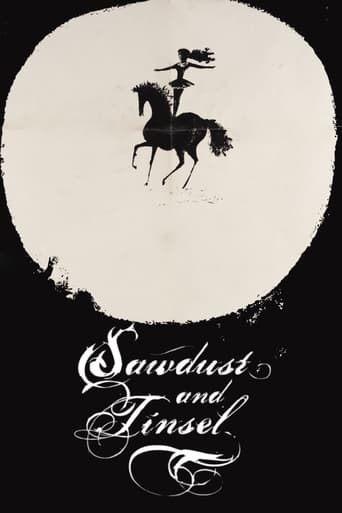Hitchcoc
Bergman can deflate you faster than a ten penny nail in a cheap tire. This is the story of people who have made decisions that have consequences way beyond their control. A two bit circus makes its way to a small town. They have lost half of their property in order to survive. Many have not been paid and the chances of performing a marketable show are diminished considerably. The ringmaster and his very young concubine are incredibly dependent on one another, but the age difference is really a negating factor. The two go to a local theatrical group to borrow costumes so they can perform. The Director makes them grovel but agrees. Albert, the ringmaster, once lived in this town and left his rather drab wife with his two sons to set out on the road. He stops to see her and begs to be let back in but no soap. Meanwhile, Anne, his young mistress set out on her own to see an actor who has tried to seduce her earlier. What ensues is one of the blackest scenes in all of cinema. But like Mother Courage lifting the poles to pull her wagon, we see that the human spirit, even when dipped in the quagmire, somehow can resurface and hope to make it to the next stop.
zetes
Another one of Ingmar Bergman's best films, this one involves a shoddy, flea-bitten circus early in the 20th Century. Ake Gronberg is the ringleader and Harriet Andersson his young, beautiful second wife. The failing circus arrives in the town where Gronberg left his first wife, who has since become a successful shop owner, and two sons. While he's away visiting them, Andersson, who (rightly) believes he is trying to dump her for a comfortable home life, sneaks off to the local theater, hoping she can hook up with an actor and leave the circus herself. This film is a constant stream of humiliation - but, as cruel as it gets, it never feels like Bergman is mocking these characters. They are quite likable, as pathetic as they are, and you suffer along with them. It's pretty much a perfect film. Shot for shot, I am in awe of it. And each performance is one for the ages. Anders Ek in particular is memorable as a rubber-faced, alcoholic clown. A flashback near the beginning of the film where he humiliates himself to protect his wife from the leering of soldiers (which she gladly invites) is one of the most gruelling sequences in the cinema - and yet it's only the beginning.
runamokprods
Less beloved by many critics than much of Bergman's best known work and I can understand why. The overly melodramatic main story of love and betrayal in a small-time circus is pretty banal stuff. But for me the film was saved by the beautiful images of the first Bergman/Sven Nyqvist teaming, and the short prologue piece – far braver and more experimental than the main body of the film itself – of a clown from the same circus and his humiliating love for an aging diva, It's so much more interesting than the very similarly themed main story that the device sort of backfires. Still, this is full enough with bravery, images and ideas, that it can compensate for its heavy- handed or over-the-top moments.
retributionpublications
This is a fantastic early film made by the master of the psychological, Ingmar Bergman. This film is much easier to understand than say, Persona, Cries and Whispers, or the Seventh Seal, and therefore, I suggest this as a first-time introduction for anyone interested in learning more about his films and/or his filming technique.This movie is quite simply, a dream. The introduction sequence is a brilliant example of Bergman's work...we see a long shot of 5 horse carriages moving across the plains at dawn, which dissolves into a reflection of a single horse & carriage in the water below a bridge, which dissolves into a series of shots...windmills, foggy paths, the carriage driver and the finally, a fade into the carriage where our protagonist, Albert Johansson, sleeps with his girlfriend Anna. Bergman is the king of the dissolve...a style he no doubt picked up from 1920's German expressionism. Bergman's mise en scene is a blend of sequences which depict a very dreamlike orientation of our immediate surrounding.The result: We are passive observers, watching the all-too-real reality of our modern world subside into something very mysterious and surreal. Bergman's style removes time from the equation of film. Time, as we know it, takes a back-seat to objects, people, and places. Real life becomes more dreamlike than any dream, and the darkest and most mysterious corner of the universe becomes the human mind.This is a fantastic movie.


